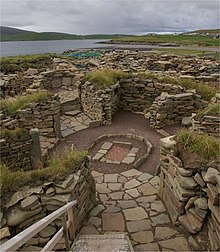Wheelhouse
A Wheel House ( German wheel ) is a generally round stone in Scotland , the interior of which is arranged radially, occasionally surrounded in the outer corners of highly rounded niches are either incorporated in the very broad, outer wall, or separated by intermediate walls are of the wall .
description
The Wheelhouse is an apparition from the Scottish Iron Age . In contrast to the Brochs , as the forerunner of which it is regarded, 62 specimens of it are only found in Caithness and Sutherland ( Tigh na Fiarnain ), on the Hebrides and the Shetland Islands . It should be noted that the term conceals various structural findings of up to ten meters in diameter and up to six meters in height. There is no standard design. The number of bays, along with features such as entrance passages and additional bays, vary from one location to another. Wheelhouses can be found in two types of locations: Machair and Moorland . With only five of the 31 Western Isles currently known to be on moorland, archaeologists have argued that this shows that Machair is a preferred site. The lack of elevation in moorland and the concentration on the Machair strips by archaeologists, however, does not give a precise picture.
In the Shetland wheelhouses , the spokes are built exclusively as dry masonry made of relatively small stones that rise over the full height of the room. In the Atlantic wheelhouses on the Western Isles ( South Clettraval ), the spokes consist mainly of radial room dividers , which are formed by large stones standing on edge. Exceptions such as the Cnip wheelhouse , Valtos, Lewis and Harris confirm the rule (if Cnip is a wheelhouse and not a roundhouse buried in the earth / midden , about which there are different opinions in the literature). In any case, the Shetland wheelhouses are all buildings above OKT.
The best-known and best-preserved wheelhouses (four systems) are located at Jarlshof on Mainland (Shetland) . Some of these wheelhouses are viewed by some authors as Pictish , although they differ significantly from the clover-leaf-shaped buildings that are clearly identified as Pictish , such as those in Jarlshof (in the form of the Pictish earth houses ) and the house found on the Broch of Gurness (farm stead ), which could be reconstructed in comparison with the not preserved Pictish houses of Buckquoy , Orkney . 62 wheelhouses have now been identified on the northern and western islands and on the north coast of Caithness and Sutherland .
There are no clear ideas about their useful life; some of them have been used as quarries until modern times. The wheelhouses of Allathasdal , on Barra and Scalavat 1 on South Uist were connected with a basement , a structure that can be connected with rituals.
In and under wheelhouses , remains of animal and human skeletons were found in niches and pits, as found in buildings from all eras and up to modern times. On the basis of these findings, the function as a cult building can be derived.
Apart from their similarity and proximity to the Brochs , which are much higher, their shape is reminiscent of some more oval systems such as Skara Brae on Orkney , as well as exact Nordic rotundas such as the systems of Eketorp or Ismantorp on Öland or the Anatolian Demircihöyük.
See also
literature
- Ian Armit: The Archeology of Skye and the Western Isles. 1996, ISBN 0-7486-0640-8 .
- Gordon Barclay: Farmers, Temples and Tombs. Birlinn, 2005, ISBN 1-84158-380-4 .
- Euan W. Mackie: The Roundhouses, Brochs and Wheelhouses of Atlantic Scotland C. 700 BC-AD 500: Architecture and Material Culture: Orkney and Shetland Isles. 2002, ISBN 1-84171-459-3 .
- Iain Crawford: The wheelhouse. In: Beverley Ballin Smith, Iain Banks: In the Shadow of the Brochs. Tempus, Stroud 2002, ISBN 0-7524-2517-X .
Individual evidence
- ↑ RJC Atkinson already connected the wheelhouse with rituals in 1957 in “Excavations of a wheelhouse and other Iron Age structures at Sollas, North Uist”: “Beneath the wheelhouse floors were a large number of pits, many containing articulated, dismembered or cremated animal burials, attesting to ritual practices ”.
Web links
- Valtos: brochs and wheelhouses (English)
- Archaeological Research in Lewis ( Memento of February 10, 2008 in the Internet Archive )
- Circular Worlds - Wheelhouses 2. ( Memento from December 23, 2012 in the web archive archive.today ) Construction based on Armit's findings for Cnip, Western Isles. ( Animated GIF )
- Forerunner of the Orkneybrochs
- Drawing and floor plan



